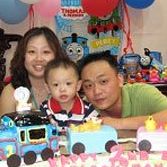Li Zheng
age ~65
from San Francisco, CA
- Also known as:
-
- Zhen G Li
Li Zheng Phones & Addresses
- San Francisco, CA
- Moreno Valley, CA
Isbn (Books And Publications)

Repair and Renovation of Concrete Structures: Proceedings of the International Conference Held at the University of Dundee, Scotland, UK on 5-7 July 2005
view sourceAuthor
Li Zheng
ISBN #
0727734059

Medicine Doctors
Wikipedia

Li Zheng
view sourceLi Zheng (Chinese: ; Pinyin: L Zhng; born 18 January 1986) is a Chinese weightlifter. Li participated in the men's -56 kg class at the 2006 World ...
Us Patents
-
Efficient Reconstruction Of Virtual Disk Hierarchies Across Storage Domains
view source -
US Patent:8478801, Jul 2, 2013
-
Filed:May 20, 2009
-
Appl. No.:12/469577
-
Inventors:Gregory M. Hutchins - San Francisco CA, US
Steven Kusalo - Fremont CA, US
Haripriya Rajagopal - Sunnyvale CA, US
Jairam Ranganathan - San Francisco CA, US
Li Zheng - Palo Alto CA, US -
Assignee:VMware, Inc. - Palo Alto CA
-
International Classification:G06F 17/30
-
US Classification:707829, 707803, 711 6
-
Abstract:A method and software is described for recreating on a target datastore a set of hierarchical files that are present on a source datastore. A content identifier (ID) is maintained for each component of the set of hierarchical files. The content ID of a component is updated when its contents are modified. The child component is copied from the source datastore to the target datastore. The content ID corresponding to the parent component on the source datastore is compared with content IDs corresponding to files present on the target datastore. When a matching content ID is discovered, it infers a copy of the parent component. The matching file on the target datastore is associated with the copied child component so that the matching file becomes a new parent component to the copied child component, thereby recreating the set of hierarchical files on the target.
-
Efficient Reconstruction Of Virtual Disk Hierarchies Across Storage Domains
view source -
US Patent:20130298125, Nov 7, 2013
-
Filed:Jul 2, 2013
-
Appl. No.:13/934127
-
Inventors:Steven Michael KUSALO - Fremont CA, US
Haripriya RAJAGOPAL - Sunnyvale CA, US
Jairam RANGANATHAN - Los Angeles CA, US
Li ZHENG - Palo Alto CA, US -
International Classification:G06F 9/455
-
US Classification:718 1
-
Abstract:A method and software is described for recreating on a target datastore a set of hierarchical files that are present on a source datastore. A content identifier (ID) is maintained for each component of the set of hierarchical files. The content ID of a component is updated when its contents are modified. The child component is copied from the source datastore to the target datastore. The content ID corresponding to the parent component on the source datastore is compared with content IDs corresponding to files present on the target datastore. When a matching content ID is discovered, it infers a copy of the parent component. The matching file on the target datastore is associated with the copied child component so that the matching file becomes a new parent component to the copied child component, thereby recreating the set of hierarchical files on the target.
-
Provisioning Executable Managed Objects Of A Virtualized Computing Environment From Non-Executable Managed Objects
view source -
US Patent:20180004555, Jan 4, 2018
-
Filed:Jun 29, 2016
-
Appl. No.:15/197552
-
Inventors:- Palo Alto CA, US
Li ZHENG - Palo Alto CA, US -
International Classification:G06F 9/455
G06F 12/08 -
Abstract:A managed object of a virtualized computing environment, which contains the runtime state of a parent virtual machine (VM) and can be placed in any host of the virtualized computing environment, is used for instantly cloning child VMs off that managed object. The managed object is not an executable object (i.e., the state of the managed object is static) and thus it does not require most of the overhead memory associated with a VM. As a result, this managed object can support instant cloning of VMs with a reduction in memory, storage, and CPU overhead relative to when a parent template VM is used.
-
Handling Disk State Inheritance For Forked Virtual Machines
view source -
US Patent:20170052812, Feb 23, 2017
-
Filed:Nov 4, 2016
-
Appl. No.:15/343454
-
Inventors:- Palo Alto CA, US
Jayanth Gummaraju - San Francisco CA, US
Hui Li - Fremont CA, US
Li Zheng - Palo Alto CA, US -
International Classification:G06F 9/455
G06F 3/06
G06F 9/44 -
Abstract:Techniques for handling inheritance of disk state when forking virtual machines (VMs) are provided. In one embodiment, a computer system can receive a request to fork a child VM from a parent VM. In response, the computer system can take a disk snapshot of the parent VM, where the disk snapshot results in a child disk for the child VM, where the child disk is a delta disk that points to a parent disk of the parent VM, and where the parent disk serves as the parent VM's current running point. The computer system can then determine whether the parent disk is a delta disk. If so, the computer system can copy the content of the parent disk to the child disk, traverse a disk hierarchy associated with the parent disk to identify a base disk above the parent disk in the hierarchy, and cause the child disk to point directly to the base disk.
-
Handling Disk State Inheritance For Forked Virtual Machines
view source -
US Patent:20160170788, Jun 16, 2016
-
Filed:Dec 15, 2014
-
Appl. No.:14/570336
-
Inventors:- Palo Alto CA, US
Jayanth Gummaraju - San Francisco CA, US
Hui Li - Fremont CA, US
Li Zheng - Palo Alto CA, US -
International Classification:G06F 9/455
G06F 3/06 -
Abstract:Techniques for handling inheritance of disk state when forking virtual machines (VMs) are provided. In one embodiment, a computer system can receive a request to fork a child VM from a parent VM. In response, the computer system can take a disk snapshot of the parent VM, where the disk snapshot results in a child disk for the child VM, where the child disk is a delta disk that points to a parent disk of the parent VM, and where the parent disk serves as the parent VM's current running point. The computer system can then determine whether the parent disk is a delta disk. If so, the computer system can copy the content of the parent disk to the child disk, traverse a disk hierarchy associated with the parent disk to identify a base disk above the parent disk in the hierarchy, and cause the child disk to point directly to the base disk.
Lawyers & Attorneys
Name / Title
Company / Classification
Phones & Addresses
Principal
King Buffet
Eating Place
Eating Place
204 E Hospitality Ln, San Bernardino, CA 92408
(909)8852338
(909)8852338
TEN DESIGN RESEARCH CENTER INC
NEW DRAGON CITY RESTAURANT INC
SAKANA ASIAN FUSION, LLC
COTTON FLOWER DESIGN LLC
ZHENGS BLUE GINGER INC
HONG KONG BUFFET WCH, INC
TAI HE IMPORT & EXPORT TRADING INC
Myspace
Googleplus

Li Zheng
Work:
Lellan - Internship UI/UX Designer (2013)
Education:
Pratt Institute - Interactive Arts, Osaka Electro-Communication University - Digital Games, Jiangnan University - Digital Media Technology

Li Zheng (Flyskywhy)

Li Zheng (Alan)

Li Zheng

Li Zheng

Li Zheng
Tagline:
Que sais-je?

Li Zheng

Li Zheng
Flickr
Plaxo

Li Zheng (李正)
view sourceShanghai副总经理 at 上海葡萄城信息技术有限公司 Past: IT经理 at 上海IEA制衣有限公司

Zheng Li
view sourceVF Imagewear

Zheng Li
view sourceSiemens

li zheng
view sourceTJKF

Da Li Zheng
view sourceBeijingTE at Enics
Classmates

Cockeysville Middle Schoo...
view sourceGraduates:
Susan Laschinsky (1977-1980),
Bryant Diersing (1967-1970),
Michael Givens (1996-1998),
LI Zheng (2000-2002),
Sharon Kepler (1977-1980)
Bryant Diersing (1967-1970),
Michael Givens (1996-1998),
LI Zheng (2000-2002),
Sharon Kepler (1977-1980)

Jefferson Junior High Sch...
view sourceGraduates:
Zheng Li (1991-1992),
Don Cabrera (1952-1956),
Damon Ewuell (1986-1989),
Latoya King (1987-1990),
Terrence Hatcher (1993-1995),
Bridgette Walton (1995-1998)
Don Cabrera (1952-1956),
Damon Ewuell (1986-1989),
Latoya King (1987-1990),
Terrence Hatcher (1993-1995),
Bridgette Walton (1995-1998)

Purdue University - Scien...
view sourceGraduates:
Walter Bartholomew (1997-2000),
Niraj Patel (1999-2002),
Brad Clark (1987-1993),
Zheng LI (2000-2004),
Laura Kozlevcar (1989-1993)
Niraj Patel (1999-2002),
Brad Clark (1987-1993),
Zheng LI (2000-2004),
Laura Kozlevcar (1989-1993)

George Washington Univers...
view sourceGraduates:
Paul Patterson (2003-2005),
Vickie Zheng Li (2003-2007),
Ameeta Chopra (1996-1998),
Sanniyyah Atlas (2001-2003),
Andrew Lacher (1982-1986)
Vickie Zheng Li (2003-2007),
Ameeta Chopra (1996-1998),
Sanniyyah Atlas (2001-2003),
Andrew Lacher (1982-1986)
Youtube

Li Wei Zheng
view source
Li Li Zheng
view source
Xue Li Zheng
view source
Li Ching Zheng
view source
Li Ying Zheng
view source
Li Zheng
view source
Evelyn Li Zheng
view source
Li Zheng Ming
view sourceGet Report for Li Zheng from San Francisco, CA, age ~65



















